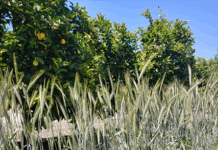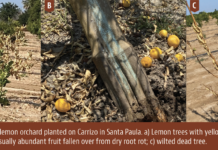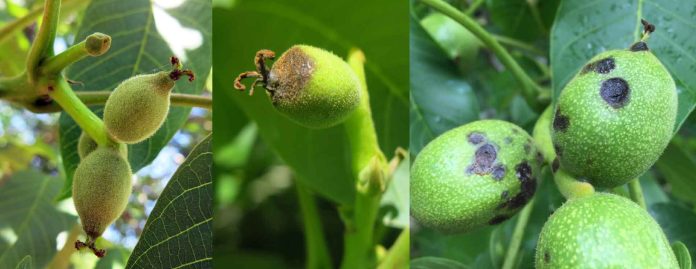
How does kasugamycin-copper or -mancozeb mixtures compare to copper-mancozeb?
Kasugamycin (tradename Kasumin) was registered in 2018 for managing walnut blight and bacterial canker and blast on sweet cherry. The bactericide was already federally registered for fire blight on pome fruit, but in 2018, registration for this disease was also approved in California. Kasugamycin is a unique bactericide because it is not used in animal or human medicine. Environmental monitoring studies have shown that it does not select for human bacterial pathogen resistance with uses in plant agriculture. Furthermore, kasugamycin has its own Fungicide Resistance Action Committee (FRAC) Code 24 or mode of action that is different from other registered plant agricultural bactericides like streptomycin (FRAC Code 25) and oxytetracycline (FRAC Code 41). Kasugamycin meets new toxicology standards for pollinating insects (e.g., honey bees), it has a low animal toxicity with a “Caution” rating and a 12 h re-entry time on the label. As with any cautionary pesticide, mixers and applicators need to have standard personal protective equipment (PPE) when handling the bactericide.
Copper is classified as FRAC Code M1 for the first element historically used for fungal and bacterial disease control. Copper affects many physiological pathways in plant pathogens and is classified as having a multi-site (M) mode of action. Not many bactericides have been developed for managing plant bacterial diseases, and fewer have been registered. Thus, there has been a great dependency on copper. Because of the multi-site classification, many agriculturalists thought that plant pathogens would not develop resistance to copper. Unfortunately, after many years of usage, bacterial pathogens such as the walnut blight pathogen, Xanthomonas arboricola pv. juglandis (Xaj), have developed resistance to copper. This is a direct result of overuse of one active ingredient (i.e., copper) and being limited with the lack of bactericides available to apply modern approaches to resistance management such as rotating between active ingredients with different modes of action and limiting the total number of applications of any one mode of action per season as part of following “RULES” (http://ipm.ucanr.edu/PDF/PMG/fungicideefficacytiming.pdf). Over-usage of any one active ingredient, such as copper, can create other environmental issues including soil contamination, orchard water-runoff, higher concentrations in watersheds, and potential crop and non-crop phytotoxicity especially in perennial crop systems.
After the industry used copper exclusively for approximately 50 years (1930s to 1980s), copper-maneb (e.g., Manex) mixtures were first identified for use on walnut in 1992 and emergency registrations ensued for 22 years before a full registration was obtained for the related compound mancozeb in 2014. The walnut industry and University of California (UC) researchers knew that more alternatives were needed, otherwise someday the pathogen would develop resistance to copper-mancozeb. Because copper resistance had already developed, this selection pressure is maintained and resistance levels are increasing even when mancozeb is used in the mixture, because copper has been the only tank mix option. In effect, resistance management is not being effectively practiced since copper-resistance already exists and the use of mancozeb (M3) is selecting for resistant strains of the bacterial pathogen to the mancozeb mode of action. Having only one treatment (i.e., mancozeb) available to manage a disease not only can limit crop production each season but could economically devastate the entire industry by making harvests sporadic and inconsistent, lowering crop quality, and preventing profitability. Growers and the entire walnut industry consider walnut blight a threat to the industry and their livelihood.
Why do we need kasugamycin for managing walnut blight?
There is a great need to develop other modes of action for managing bacterial diseases including walnut blight that can be integrated into management programs. Kasugamycin was identified, developed, and registered for the purpose of resistance management, reducing over-usage of any one mode of action, and sustaining the walnut industry of California. The aminoglycoside bactericide has a unique mode of action (FRAC Code 24) as stated above and can be used in combination with copper or mancozeb. When kasugamycin is used in combination with mancozeb, resistance management is being practiced since resistance has not been found in Xaj pathogen populations to either mode of action.
Use on Walnuts
Kasugamycin is labeled as Kasumin for managing walnut blight at 64 fl oz/A in a minimum of 100 gal water/A for ground application. The full 64 fl oz per acre labeled rate for kasugamycin should always be used. Adjuvants that are stickers may also be used, whereas spreaders and penetrants should be avoided. Reduced spray volumes may be utilized for small trees provided that the volume of water is sufficient to provide good coverage of treated foliage. Applications should be initiated when conditions favor disease development. This is the same timing as for copper-mancozeb. In orchards with a history of the disease and when high rainfall is forecasted, applications should be initiated at 20-40 percent catkin expansion. Under less favorable conditions for disease (i.e., low rainfall forecasts and minimal dews), applications should start at 20-40 percent pistillate flower expansion (also known as the “prayer stage”). The preharvest interval is 100 days or approximately mid- to late June depending on the walnut cultivar harvest date. The minimal re-application interval is seven days. The current labeled uses of Kasumin allows for two applications or 128 fl oz of product per season with a label change for up to four (256 fl oz) per season planned later this year. Still, only two consecutive applications will be allowed without rotating to other modes of action. Alternate row applications, applications in orchards that are being fertilized with animal waste/manure, or animal grazing in orchards treated with Kasumin are not allowed. The first restriction is to prevent selection of resistant isolates of the target pathogen, Xaj; whereas, the latter two restrictions are to ensure that the selection of non-target, human-pathogen bacteria is prevented.
For walnut blight management, the best way to use the bactericide is in combination with mancozeb or copper. Application management strategies for a four- or five-spray mixture, rotation program include, but are not limited to, the following:
A) Copper/mancozeb—kasugamycin/mancozeb—kasugamycin/copper—copper/mancozeb
B) Copper/mancozeb—kasugamycin/mancozeb—copper/mancozeb—kasugamycin/copper — copper/mancozeb
How do kasugamycin treatments compare to copper-mancozeb treatments in managing disease?
The research used to develop kasugamycin was based on a 7- to 10-day re-application interval. The reason for this was that Kasumin is locally systemic or translaminar and thus, is less likely to be re-distributed. With new growth increasing the canopy volume weekly in the spring as walnut trees come out of dormancy, multiple and frequent applications are necessary. Kasugamycin-mancozeb mixtures applied in our research trials were often the most effective of all treatments evaluated.
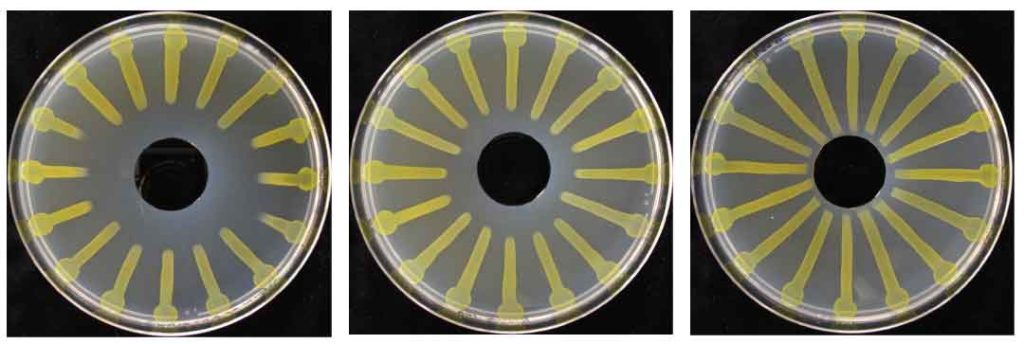
In general, bactericides have a short residual life of a few days to a week or two. In toxicology in-vitro testing, Xaj is only moderately sensitive to kasugamycin with a mid-range to high minimum inhibitory concentration (MIC) value. When kasugamycin is mixed with mancozeb, the MIC of the mixture is approximately 5 parts per million (ppm). Kasugamycin is applied at 64 fl oz per 100 gal or 100 ppm. Thus, the labeled rate of kasugamycin-mancozeb mixtures are approximately 20X of the MIC value for Xaj. Because of the short residual activity and a moderate buffering residue (20X), the rotation of bactericide mixtures containing kasugamycin described above need to be applied in 7- to 10-day intervals.
Kasugamycin and Resistance.
Resistance is a relative term indicating a change in sensitivity to an inhibitory compound. A moderately high MIC for a bactericide does not mean that the pathogen is resistant. We have conducted baseline studies with kasugamycin, kasugamycin-copper, and kasugamycin-mancozeb for Xaj with MIC values of 20, 8.3, 5.3 ppm, respectively. This was done before the bactericide was registered in California to determine any change in sensitivity after registration and commercial usage. To date, resistance has not been found and isolates evaluated are all within the baseline distributions. Still, with a single site mode of action compound such as kasugamycin, there is a risk for selecting resistant sub-populations of the pathogen especially when resistance management strategies are not employed. This is the reason why we developed the mixture-rotation programs suggested above.
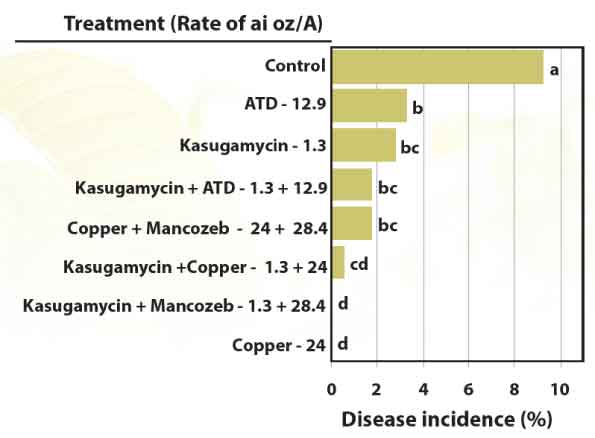
Conclusions
The integration of bactericides with different modes of action and application strategies of rotations of mixtures of bactericides with different modes of action with forecasting tools such as XanthoCast (http://www.agtelemetry.com/) should provide the stewardship necessary for having the tools available for managing walnut blight for years to come. The hope with the Kasumin registration is to provide resistance management and prevent or reduce the risk of resistance to copper-mancozeb while new approaches can be developed and integrated to protect both of these compounds. Walnut blight is the most serious disease impacting growers in California and multiple tools like kasugamycin, copper, and mancozeb need to be available to maintain a successful industry.











